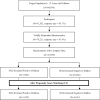Abnormal body mass index may be related to poor social function of female children by a propensity score matching analysis
- PMID: 33737721
- PMCID: PMC7973791
- DOI: 10.1038/s41598-021-85911-1
Abnormal body mass index may be related to poor social function of female children by a propensity score matching analysis
Abstract
This study sought to estimate the association of children's body mass index (BMI) with their social function in Shanghai China. A large population-based cross-sectional study based on a propensity score matching (PSM) analysis was conducted. BMI was compared according to social communication questionnaire (SCQ) classification, and then SCQ score was compared in terms of BMI grouping before and after PSM. A positive SCQ was considered to indicate poor social communication and a negative SCQ was then supposed to be normal. After 1:3 matching, a total of 7563 children aged 3-12 years were included in analysis. There were statistically significant positive correlation of BMI with SCQ scores for obese females of school age (R2 = 0.043, p < 0.001) and negative correlation of these two variables for school-aged females with malnutrition (R2 = 0.047, p = 0.027). In conclusion, BMI may be characterized as one of predictive factor for poor social function of these children.
Conflict of interest statement
The authors declare no competing interests.
Figures


Similar articles
-
[Simple obesity in children. A study on the role of nutritional factors].Med Wieku Rozwoj. 2006 Jan-Mar;10(1):3-191. Med Wieku Rozwoj. 2006. PMID: 16733288 Review. Polish.
-
Association between school food environment and practices and body mass index of US public school children.J Am Diet Assoc. 2009 Feb;109(2 Suppl):S108-17. doi: 10.1016/j.jada.2008.10.065. J Am Diet Assoc. 2009. PMID: 19166665
-
Health-related quality of life among children and adolescents: associations with obesity.Int J Obes (Lond). 2006 Feb;30(2):267-72. doi: 10.1038/sj.ijo.0803107. Int J Obes (Lond). 2006. PMID: 16231035
-
[Reliability and Validity of the Turkish Version of the Social Communication Scale.].Klinik Psikofarmakol Bulteni. 2012 Jan;22(1):43-50. doi: 10.5455/bcp.20111212091514. Klinik Psikofarmakol Bulteni. 2012. PMID: 25580078 Free PMC article. Turkish.
-
Influence of diet, physical activity and parents' obesity on children's adiposity: a four-year longitudinal study.Int J Obes Relat Metab Disord. 1998 Aug;22(8):758-64. doi: 10.1038/sj.ijo.0800655. Int J Obes Relat Metab Disord. 1998. PMID: 9725635
Cited by
-
Relationship of weight-adjusted waist index and developmental disabilities in children 6 to 17 years of age: a cross-sectional study.Front Endocrinol (Lausanne). 2024 Jul 4;15:1406996. doi: 10.3389/fendo.2024.1406996. eCollection 2024. Front Endocrinol (Lausanne). 2024. PMID: 39027477 Free PMC article.
-
Association of anthropometric parameters with intelligence quotient in early school-aged children: a cross-sectional study in Iran.BMC Pediatr. 2024 Dec 18;24(1):809. doi: 10.1186/s12887-024-05303-y. BMC Pediatr. 2024. PMID: 39696032 Free PMC article.
References
Publication types
MeSH terms
LinkOut - more resources
Full Text Sources
Other Literature Sources
Medical
Miscellaneous

